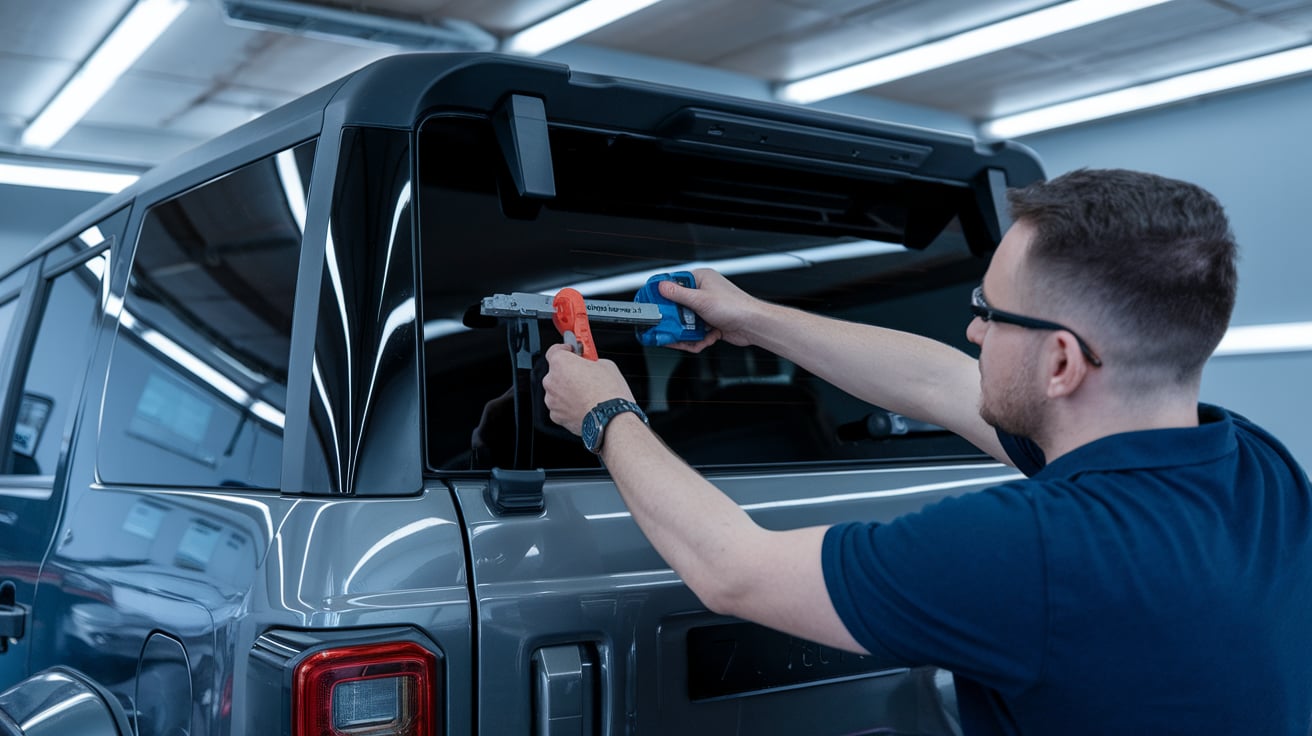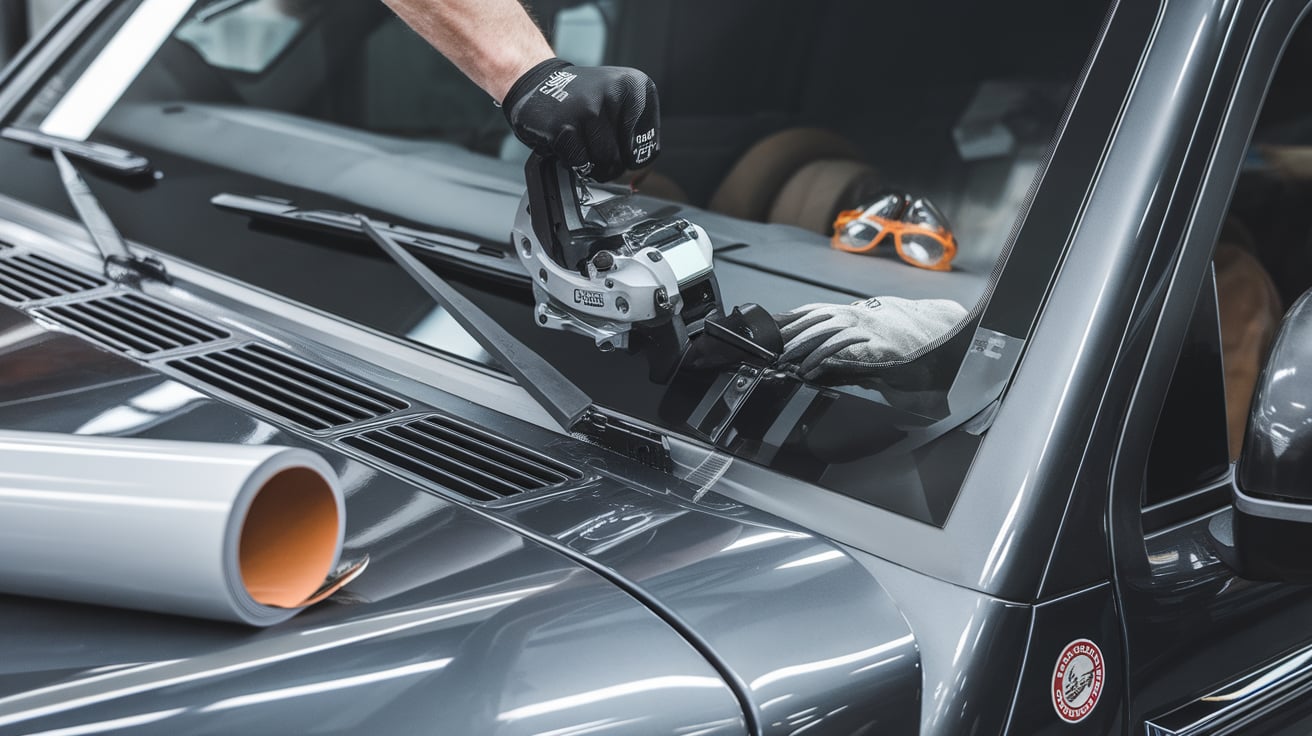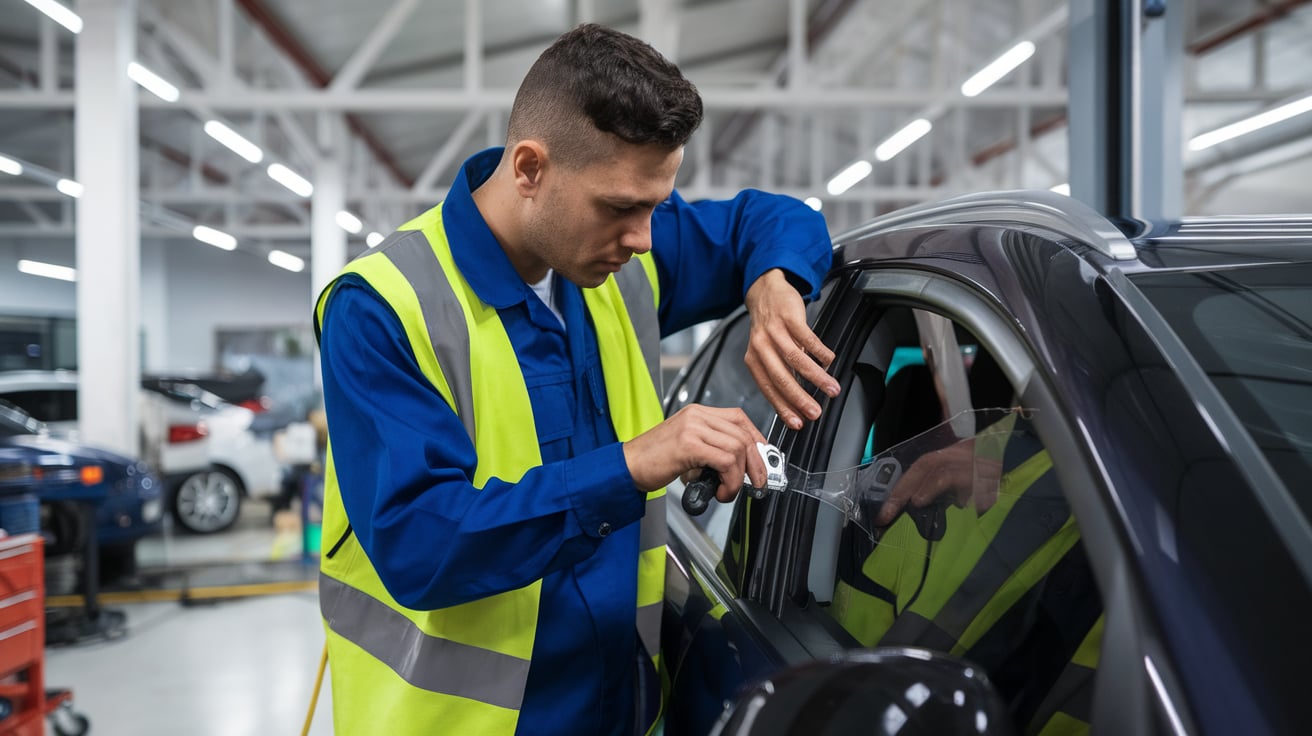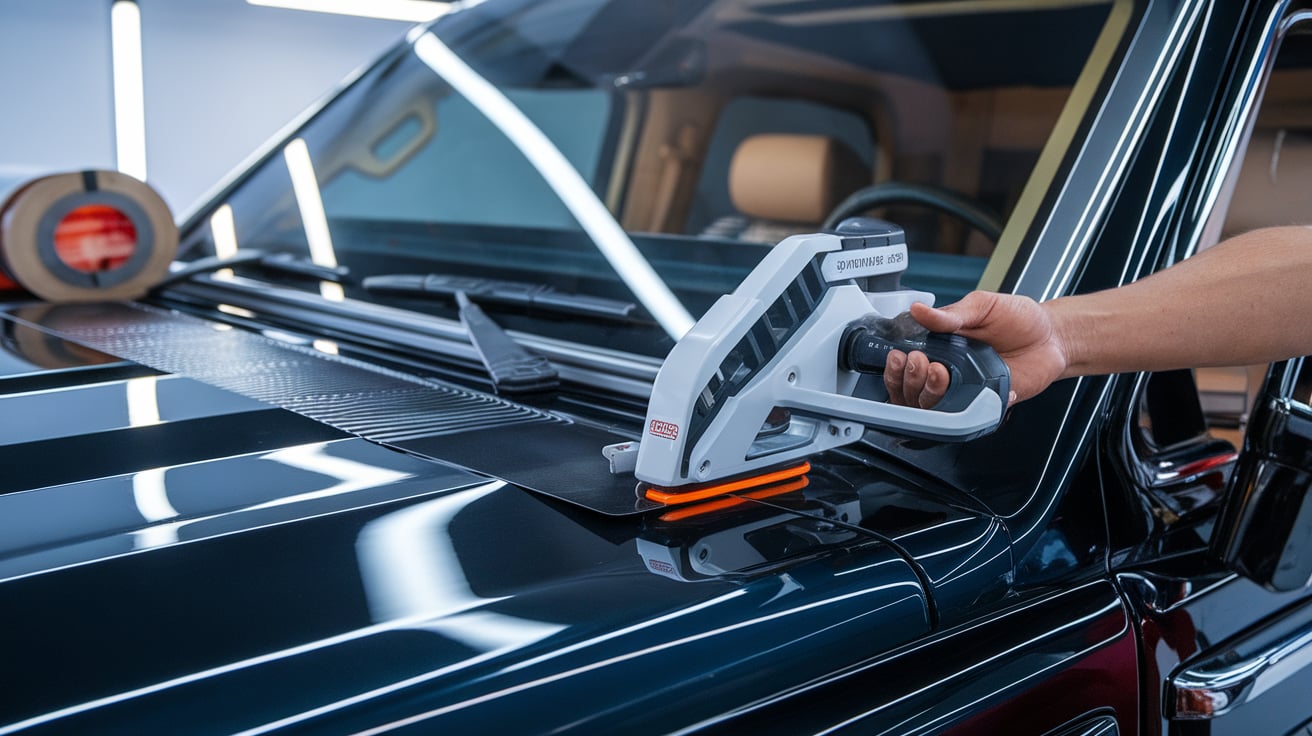Why Film Waste Is a Profit Killer in Tinting Shops. Film waste is not just annoying, it’s expensive. In Dubai’s tinting market, where high-end cars demand precision, every miscut or bad alignment means lost profit.
Window film waste can eat up 10–15% of your inventory monthly. That’s not just tinting material loss, it’s time, labor, and reputation slipping through the cracks. One wrong cut on Bentley’s rear glass? That’s $40 gone in seconds.
Shops that rely on guesswork or manual layouts are burning through film. The solution? Film-saving tinting tools. These tools boost tinting efficiency, reduce scrap, and help protect your margins. If you’re still eyeballing cuts or trimming by hand, it’s time to rethink the workflow.
Understanding Film Waste | Where It Happens and Why It Matters
Film waste isn’t random; it’s rooted in predictable, fixable mistakes. Most tinting shops lose material due to window film cutting errors, misalignment, and poor prep. A single miscut on a curved rear windshield can trigger edge lifting, forcing a full rework and doubling labor time. Common causes of tinting film loss include:
- ❌ Wrong roll sizes: Using 20″ rolls on 18″ windows leads to excess trimming and scrap.
- ❌ Manual miscuts: Freehand cutting often results in uneven edges and wasted film.
- ❌ Poor alignment: Misplaced templates or rushed installs cause bubbles and peeling.
- ❌ Rework cycles: Fixing bad installs means burning through more film and labor.
These errors compound fast. A shop doing 5–10 cars daily can lose hundreds in material each week. That’s where film-saving tinting tools come in. From precision plotters to smart layout software, these tools eliminate guesswork and reduce waste by up to 30%. They’re not just upgrades, they’re cost-control essentials. If you’re serious about profitability, start by eliminating the silent killer: film waste.

Film Saving Tinting Tools | The Gear That Cuts Waste to Zero
Let’s be blunt, manual cutting and eyeballed layouts belong in the past. If you’re still trimming film by hand or guessing roll sizes, you’re not just wasting material, you’re wasting money.
Film-saving tinting tools are designed to solve this. They’re not luxury add-ons. They’re the backbone of a lean, efficient tinting operation. Think of them as your silent crew, working behind the scenes to protect every inch of film. From plotters that cut with laser precision to software that calculates the perfect layout, each tool plays a role in reducing window film cutting errors, miscuts, and rework. Let’s break them down, one by one.
And if you’ve ever debated between Pre-Cut vs. Custom Tint, this is exactly where the difference shows. Pre-cut kits, supported by precision tools, minimize waste and guarantee accuracy. On the other hand, custom cutting relies more heavily on skill and can lead to errors without these film-saving systems. Our dedicated blog on Pre-Cut vs. Custom Tint dives deeper into the pros and cons—helping you see how the right choice can save both time and material.
Tool 1: Plotter-Based Film Cutting Systems
When precision meets automation, waste doesn’t stand a chance. Plotter-based systems are the cornerstone of modern Film Saving Tinting Tools, designed to eliminate human error and maximize material usage.
- Digital Templates: These machines use pre-loaded vehicle templates to cut film with exact dimensions, no trimming, no guesswork.
- Consistent Cuts: Whether it’s a sedan or SUV, every piece is cut identically, reducing the risk of misalignment or redo.
- Roll Optimization: Advanced models calculate the most efficient way to use each roll, minimizing leftover scraps.
In high-volume tint shops, this tool alone can save thousands in film costs annually. It’s not just about speed, it’s about control. Among all Film Saving Tinting Tools, plotters offer the most immediate ROI. They turn tinting into a science, not an art.
Tool 2: Film Cut Optimizer Software
If plotters are the hands, cut optimizer software is the brain behind modern film-saving tinting tools. These programs, like Tint Wiz, analyze every job to calculate the most efficient way to use your film rolls, down to the last centimeter.
Smart Layout Optimization
Instead of manually guessing how to position each window template, the software auto-generates layouts that reduce overlap and trim waste. It considers roll width, window shape, and even film type to create the tightest possible fit.
Roll Size Calculator
One standout feature is the roll size calculator, which recommends the ideal roll width for each job. Whether you’re working with 20″, 36″, or 60″ rolls, the system ensures you’re not overusing premium film on small windows.
Workflow Snapshot
Here’s how it typically works:
- Upload a vehicle template or select from the database.
- Input roll widths available.
- Software runs layout optimization.
- Preview the cut plan and material usage.
- Send to the plotter or print the layout guide.
This tool doesn’t just save film, it saves time, decision fatigue, and costly reorders. Among all film-saving tinting tools, cut optimizer software offers the deepest insight into your material strategy. In a competitive market, smart usage isn’t an option; it’s survival. That’s why this software is a must-have in the arsenal of film-saving tinting tools.
Tool 3: Precision Knives and Manual Cutters for Edge Work
Even with plotters and software doing the heavy lifting, the final finesse still comes down to handwork. That’s where precision blades and manual cutters earn their place among essential film-saving tinting tools.
Sharpness = Accuracy
A fresh snap-off blade ensures clean, controlled cuts, especially around tight corners, rubber trims, and curved glass. Dull blades cause drag, tearing, and costly film damage.
Ergonomic Grip Matters
Comfortable, non-slip handles reduce hand fatigue and improve control during edge trimming. Whether you’re slicing excess film or refining a corner, grip stability is key to precision.
Edge Trimming Mastery
Manual cutters allow for micro-adjustments that machines can’t replicate. They’re perfect for:
- Final edge cleanup
- Trimming around sensors or defroster lines
- Adjusting film near seals and gaskets
While they may seem basic, these tools are irreplaceable in the hands of a skilled installer. No set of film-saving tinting tools is complete without a reliable manual cutter for finishing work. Precision isn’t optional; it’s the difference between a flawless install and a callback.

Tool 4: Cutting Mats, Guides, and Alignment Systems
Precision starts at the surface. Among the most underrated film-saving tinting tools, cutting mats and straightedge guides play a critical role in layout accuracy and material control.
Grid Alignment & Slip Prevention
A high-quality cutting mat with printed grids helps installers align film pieces perfectly before trimming. The non-slip surface prevents shifting, ensuring clean lines and consistent dimensions.
Straightedge Guide for Clean Cuts
Pairing the mat with a straightedge guide allows for razor-straight cuts, especially useful when prepping strips or custom shapes. It reduces the risk of crooked edges and wasted film.
These tools may seem simple, but they eliminate the small errors that add up over time. In the world of film-saving tinting tools, consistency is king, and mats and guides are the foundation of that consistency.
Whether you’re working on a bench or mobile setup, these tools ensure every cut starts clean and stays aligned. That’s why they belong in every pro’s kit of film-saving tinting tools.
Tool 5: Template Libraries and Pre-Cut Film Patterns
Speed and accuracy go hand in hand, and that’s exactly what film-saving tinting tools like template libraries deliver. These digital databases contain thousands of pre-cut templates for vehicles, making trial-and-error cutting a thing of the past.
Pattern Database Power
Whether you’re using proprietary software or cloud-based systems, access to a robust pattern database means you can select the exact shape and size for each window. These templates are built from real-world measurements, ensuring perfect fitment every time.
Repeatable Shapes, Faster Workflow
Once a template is selected, it can be reused across multiple jobs. This repeatability speeds up workflow, reduces cutting mistakes, and minimizes wasted film, making it one of the most efficient film-saving tinting tools in your arsenal.
Smart Integration
Many systems integrate directly with plotters and layout software, allowing you to go from template selection to cut execution in minutes. No manual tracing. No second-guessing.
In the world of film-saving tinting tools, template libraries are the shortcut to precision. They don’t just save time, they save material, reduce stress, and elevate your shop’s professionalism.
Tool 6: Roll Size Selection Tools and Calculators
Choosing the wrong roll width is one of the fastest ways to waste film. That’s why smart film-saving tinting tools include roll size selectors and calculators that match your job to the perfect roll.
Roll Width Selector
Whether you’re working with 36″, 48″, or 60″ rolls, a roll width selector helps you avoid excess trimming and leftover scraps. It analyzes window dimensions and recommends the most efficient roll for each cut.
Film Calculator for Optimization
These tools also factor in layout orientation, vehicle type, and film type to generate a usage plan. The result? Less waste, fewer roll changes, and smoother workflow.
In a high-volume shop, every inch of film counts. That’s why these calculators are more than just helpers; they’re essential film-saving tinting tools. From planning to execution, roll optimization is the quiet hero of material efficiency. And no set of film-saving tinting tools is complete without it.
Tool 7: Integrated Mobile & Desktop Tinting Platforms
In today’s fast-paced tinting world, mobility matters. That’s why modern film-saving tinting tools now include cloud-based platforms that sync across mobile and desktop devices, giving installers real-time access to jobs, templates, and layout plans.
Mobile Tinting Software
Apps allow techs to pull up vehicle templates, adjust layouts, and preview cuts directly from their phones or tablets. This reduces miscommunication and ensures every installer is working from the same data.
Desktop Tinting Tools
On the shop floor, desktop platforms offer deeper control, ideal for layout optimization, roll planning, and template editing. Together, they create a seamless cross-device workflow that minimizes errors and maximizes efficiency.
Whether you’re in the bay or on the road, these platforms keep your team aligned. As film-saving tinting tools, they eliminate guesswork and bring precision to every job. In short, integrated platforms aren’t just convenient, they’re essential film-saving tinting tools for modern tinting operations.
That’s also why Pre-Cut Window Tints are becoming the go-to choice for many workshops. Instead of wasting film with trimming errors or redo’s, pre-cut patterns fit perfectly from the start—saving time, reducing waste, and ensuring a flawless finish every time.

Workflow Integration | How to Use These Tools Together
Having the right film-saving tinting tools is one thing; knowing how to use them together is what separates efficient shops from wasteful ones. When integrated properly, these tools create a streamlined tinting workflow that cuts film waste to near zero. Here’s how a typical job flows:
- Start with the template library
Select the vehicle and pull up accurate pre-cut patterns. - Run the cut optimizer software
Use layout tools to position templates and calculate ideal roll widths. - Choose the right roll size
Input dimensions into the film calculator to avoid excess trimming. - Send the layout to the plotter
Let the machine handle precision cuts based on optimized data. - Finish with manual cutters
Use precision blades for final edge work and tight corners. - Use mobile or desktop platforms
Sync job data across devices for real-time adjustments and team coordination.
This kind of tool synergy eliminates guesswork, reduces rework, and protects your margins. When used together, film-saving tinting tools become more than equipment; they become a system. And in a competitive market like Dubai, that system is your edge.
Choosing the Right Film-Saving Tinting Tools for Your Shop
Not all film-saving tinting tools are created equal, and not every shop needs the full stack. Tool selection should reflect your workflow, car types, and service volume.
- Small shops or mobile units benefit from compact, budget-friendly options like handheld cutters, basic film calculators, and manual layout guides.
- Mid-sized operations should invest in scalable systems, plotters with template libraries, cloud-based layout software, and roll-width optimizers.
- High-volume shops need full integration: automated cutting systems, multi-user platforms, and advanced analytics to track waste and efficiency.
Consider your average job type: Are you mostly handling sedans, SUVs, or luxury vehicles? Match your tools to the precision and speed required. The right film-saving tinting tools don’t just reduce waste, they scale with your business. Choose tools that grow with you, not ones you’ll outgrow in six months.

Precision Tools Are the Future of Tinting
In a market driven by speed, accuracy, and sustainability, film-saving tinting tools are no longer optional; they’re essential. Zero waste tinting isn’t a dream; it’s a tool-driven reality. Shops that embrace future-proof tinting workflows not only save material but also boost output and customer satisfaction. For drivers who want the same level of precision and value, explore our Car Tinting Dubai Services on the home page and see how we bring efficiency, style, and protection together.
If you’re still relying on manual guesswork, you’re leaving money on the table. Upgrade your toolset, streamline your process, and position your shop for long-term growth. Precision is the new standard. Efficiency is the new currency. And the future? It belongs to those who think smarter.

